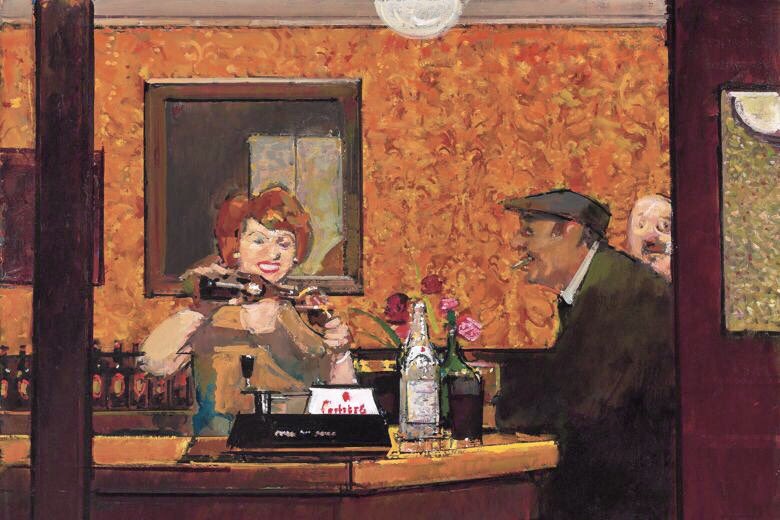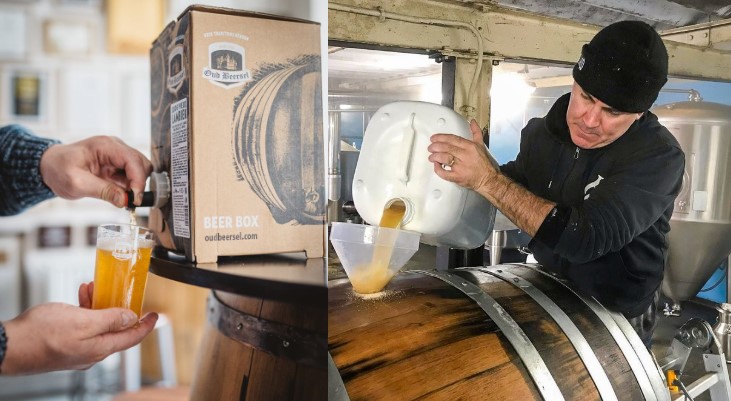It’s been difficult to cope with the changing of the seasons as I have for every other year I’ve ever been on the planet. Familiar things – like heat or evenings – just seem to have gone away. But the week of Hallowe’en every four years helps set a milestone that’s hard not to stub your toe upon. So here we are. Orange leaves turning to wet bran flakes in the ditch. Speaking of orange, I saw the image above passing by upon the glowing screen this week, one of a series of four pub scenes by Ruskin Spear (1911-90) whose art included “the citizens of Hammersmith relaxing in local pubs.”  Happy people in pubs… or not… also was the topic of my Zoom chat with Boak and Bailey. We had never met before but we chatted away for two hours last Sunday. Blogging. Brewing history. Pandemic. Gossip. Very grateful to have been invited by them. I took a very fuzzy photo to commemorate the moment.
Happy people in pubs… or not… also was the topic of my Zoom chat with Boak and Bailey. We had never met before but we chatted away for two hours last Sunday. Blogging. Brewing history. Pandemic. Gossip. Very grateful to have been invited by them. I took a very fuzzy photo to commemorate the moment.
Out there in a more focused reality, Jessica Mason wrote wonderfully about visiting a neighbour:
I wondered, momentarily, if I should tell her what I did for a living when I wasn’t visiting people in the mornings. Tell her about the industry I worked in. About the drinks and hospitality sector or any of the magazines for which I’d written. I wanted so much for her to know that it wasn’t just her feeling lost and alone. That entire sectors of society had been overlooked and that the paucity of support for those in need had begun to force people into poverty. Do I tell her that I’m really a drinks and pubs writer? That later on that day I’d be at a desk looking for the right words to describe something that made people feel good and interested. Things that reflected our thoughts, tastes and individuality.
In Scotland, a ruling has come down on the meaning of cafe during pandemic, the sort of ruling we may be seeing more and more of in the coming weeks and months as the cold and dark comes upon us. In this case, an injunction was granted against a municipal order to shut based upon the legal principle “surely to heavens this could not be a cafe!”:
“The council’s main, final reason for forcing us to close was that some of our dishes were ‘too smart and too fancy’ for us to be considered a cafe. “Nothing in the law dictates how smart you can or can’t have your food in a cafe.” One20 was granted an interim suspension order by the Court of Session after an online hearing on Friday, 23 October and remains open this weekend.
Further to the south, in Manchester a different legal consideration on the nature of food service was before the Covid considering authorities:
The head of Greater Manchester Police Licensing got on the blower to let us know that Slice Gate has been revisited and our Nell’s Pizza slices (cut from 22 inch pizzas) are now officially deemed substantial.
And to the left, further west, we learn of this heartwarming tale from Northern Ireland:
A man threw a tin of beer over a PSNI officer and shouted “Up the ‘Ra” after being told to return home during the lockdown, a court heard yesterday. Neil Murphy (37) was given 12 months probation for the assault on police and disorderly behaviour outside his flat in north Belfast.
Nice one, Neil. Well handled pandemic response. What’s the “‘Ra”? Short form for the “‘Rona”?
Ryan Avent of The Economist wrote a worthwhile series of tweets that add up to a good remembrance of the phenomenon of blogging which, of course, continues hereabouts and many other places under other names including journalism:
Blog posts could of course blow up. But the potential for instant mass virality was smaller, because drawing attention to blog posts meant creating a post of one’s own, and even link roundups took a bit of effort… As snarky as blogging could be, the medium generally demanded a minimal level of argument and contextualization greater than what’s asked of twitter users: if, at least, one wanted to attract others’ time and attention.
 Going further back, Eoghan posted a photo of his beer book bookshelf and started a trend in posting photos of one’s beer book bookshelves. Me, I have more piles and piles of piles of books by the easy chair myself. There’s a copy of The Chronicles of the Maltmen Craft in Glasgow 1605-1879 in there somewhere. Which I know makes you all riddled with jealousy.
Going further back, Eoghan posted a photo of his beer book bookshelf and started a trend in posting photos of one’s beer book bookshelves. Me, I have more piles and piles of piles of books by the easy chair myself. There’s a copy of The Chronicles of the Maltmen Craft in Glasgow 1605-1879 in there somewhere. Which I know makes you all riddled with jealousy.
Be prepared. Whenever anyone posts a graph for any reason at all, I am going to quote this guy who wins for this week’s most fabulous gnumbskullery*:
I think that’s hard to conclude from this chart. It might still be true, but i think it’s a lot more complex with alot more unanswered questions.
One of my personal heroes is Katie Mathers, as you may have guessed, and I am saddened to hear that she has met up with the virus… but cheered that she’s found a positive angle:
…it’s actually quite cool that I have something that’s spread all over the world. A big viral connection to the globe…
Here is an update to the story from the Ithaca NY area, the one about the brewery that had to close because it brewed old school micros that no one wanted. Well, the facility has been bought but some downstate operation”
Big aLICe, headquartered in Long Island City, Queens, has reached a deal to buy the former GAEL Brewing Co. on State Route 14 just south of Geneva on Seneca Lake. GAEL owner George Adams announced his brewery’s closing earlier this month. Big aLICe co-owners Kyle Hurst and Scott Berger hope to have the new brewery and taproom open early in 2021. Big aLICe, which also has a tasting room in Brooklyn, is known for a wide range of beers, from hazy New England IPAs and pilsners to sours and barrel-aged brews.
Well, there is some sort of lesson there. You can shape it as you like.
In other business news, we hear a lot about the challenges faced by the hospitality sector and how it affects brewing but here is an interesting story about the challenges faced by Canadian drinks exporters:
…beer exports are down too. Year-to-date sales to the end of July are down 13 per cent compared to the same period last year, trade association Beer Canada data show. Pacific Rim Distributors, the leading distributor of B.C. craft beer, has certainly felt pandemic pain. “We saw a deeper drop in sales in the first quarter because COVID-19 hit Asia before North America,” says Garett Senez, vice-president of marketing for the North Vancouver-based firm representing 13 craft brewers in 19 foreign markets.
Interesting that Ontario’s own “Collective Arts plans to open a satellite brewery in Brooklyn next year.”
Otherwise, beer continues to get more and more boring according to the latest Euro-gak news:
Drinks giants have reported higher alcohol-free beer sales in the latest sign the low- and no-alcohol drinks sector continues to grow. Heineken and Carlsberg have both created alcohol-free versions of their flagship beer labels, Belgian brewer AB InBev recently launched a low-alcohol alternative to Stella Artois, and this week drinks giant Diageo launched a booze-free version of Guinness in Britain and Ireland. Danish brewer Carlsberg – behind the Tuborg and Kronenbourg brands – on Wednesday reported a 29% growth across its alcohol-free brews in the three months to September, compared to the same period last year.
Similarly, the Boston Seltzer and Hard Iced Tea Co. has seen its shares soar.
Speaking of the tactics of macro-gak, Heineken in the UK has been caught forcing its own pubs to sell its own beer… which sounds a bit weird to someone not in the UK:
Heineken has been fined £2m for forcing publicans to sell “unreasonable” amounts of its own beers and ciders. The pubs code adjudicator (PCA), an official who oversees the relationship between pub-owning companies and their tenants, said Heineken had “seriously and repeatedly” breached laws that protect publicans from company behaviour aimed at prohibiting pubs selling competitor brands.
Finally, to top off a less than cheery week, Jeff noted the extinguishment of the All About Beer online archives. I was more written of than wrote in that organ but it did speak to an era or two, thriving in micro times, collapsing under a shoddy hand through perhaps the peak of craft. We have left that behind.
There you are. Less actual beer news that most weeks. But remember that, as the days shorten in the coming darkest third of the year northern hemispherically speaking, there’s more out there. Boak and Bailey mostly every Saturday, plus more at the OCBG Podcast on Tuesdays (this week Jordan skips his obligations to the sponsors!!!) and sometimes on a Friday posts at The Fizz as well. And sign up for Katie’s weekly newsletter, The Gulp, too. Plus the venerable Full Pint podcast. And Fermentation Radio with Emma Inch. There’s the AfroBeerChick podcast as well! And have a look at Brewsround‘s take on the beer writing of the week. Not to mention Cabin Fever. And Ben has finally gone all 2009 and joined in with his own podcast, Beer and Badword. And remember BeerEdge, too.
*The “g” is sometimes even silent.











